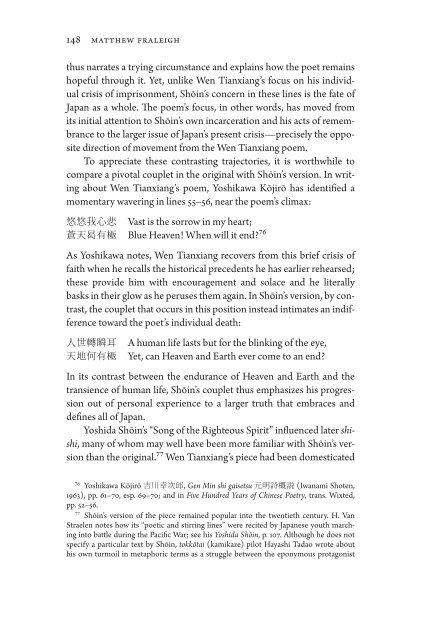JAPANESE SONGS OF HIGH PURPOSE 147<strong>the</strong>rmore, similarities among <strong>the</strong> couplets in <strong>the</strong>ir syntactic structure<strong>and</strong> semantic value create links within Shōin’s gallery; <strong>the</strong> “literary vassal”<strong>of</strong> line 12 <strong>of</strong>fsets <strong>the</strong> “military vassal” <strong>of</strong> line 14, for example, <strong>and</strong><strong>the</strong> polysemy <strong>of</strong> a place name such as Akō (line 15) echoes <strong>the</strong> multipleasso ciations called up by <strong>the</strong> characters for Wake (line 17).Just as <strong>the</strong> ultimate couplet <strong>of</strong> <strong>the</strong> first section <strong>of</strong> Shōin’s poem(lines 9–10) provides a transition to <strong>the</strong> following section, so too does<strong>the</strong> second section <strong>of</strong> Shōin’s poem end with a transitional couplet(lines 25–26), a feature absent from <strong>the</strong> Wen Tianxiang original. Thiscouplet implicitly invites readers to see <strong>the</strong> ten historical figures just recalledas linked not only by <strong>the</strong>ir shared status as sites <strong>of</strong> remembrancealong <strong>the</strong> poet’s journey from Hagi to Edo, but by <strong>the</strong>ir putative sharedrole in Japanese history. Just as <strong>the</strong>se recollected figures span <strong>the</strong> entirearchipelago, unifying its territory, so too have <strong>the</strong>y promoted unity <strong>and</strong>prevented division over <strong>the</strong> course <strong>of</strong> history. If this particular reading<strong>of</strong> Shōin’s works better for some <strong>of</strong> <strong>the</strong> enumerated incidents than foro<strong>the</strong>rs, <strong>the</strong> third section declaims more directly that <strong>the</strong> focus <strong>and</strong> basis<strong>of</strong> this unity lies in <strong>the</strong> imperial house, its capital, <strong>and</strong> <strong>the</strong> national territoryitself. In this section, after enumerating <strong>the</strong> domestic sites connectedto <strong>the</strong> imperial house in <strong>the</strong> opening lines, <strong>the</strong> poet <strong>of</strong>fers afleeting glimpse <strong>of</strong> <strong>the</strong> world beyond Japan (line 30). Just as <strong>the</strong> sacredsites <strong>of</strong> Henan’s <strong>Songs</strong>han <strong>and</strong> Shaanxi’s Huashan, two <strong>of</strong> China’s celebrated“five mountains,” threaten to impinge upon <strong>the</strong> poem’s field<strong>of</strong> vision, <strong>the</strong> poet peremptorily refocuses his gaze with insular confidenceon Japan’s status as a “divine l<strong>and</strong>” that occupies a special placeamid a myriad <strong>of</strong> o<strong>the</strong>r nations (line 33).The tentative, disinterested glance beyond Japan’s borders that isintroduced in this sequence anticipates <strong>the</strong> transition to <strong>the</strong> fourthsection, in which an unexpected foreign incursion disrupts <strong>the</strong> idyllicequilibrium. Having asserted that <strong>the</strong> defining feature <strong>of</strong> <strong>the</strong> historicalheroes in <strong>the</strong> gallery is <strong>the</strong>ir ability to restore unity in troubled times,Shōin’s detailing <strong>of</strong> <strong>the</strong> threat to Japan’s unity <strong>and</strong> stability—initiallyintroduced by <strong>the</strong> incursion <strong>of</strong>, <strong>and</strong> <strong>the</strong> concessions made to, foreignpowers (lines 35–46)—suggests that <strong>the</strong> time is ripe for <strong>the</strong> emergence<strong>of</strong> ano<strong>the</strong>r such heroic figure. Now, in 1859, five or six years afterPerry, Shōin remains inspired by his faith in <strong>the</strong> emperor (line 49–50)<strong>and</strong> maintains his own personal resolve <strong>and</strong> determination (line 57–60). As in Wen Tianxiang’s “Song,” <strong>the</strong> fourth section <strong>of</strong> Shōin’s poem
148 MATTHEW FRALEIGHthus narrates a trying circumstance <strong>and</strong> explains how <strong>the</strong> poet remainshopeful through it. Yet, unlike Wen Tianxiang’s focus on his individualcrisis <strong>of</strong> imprisonment, Shōin’s concern in <strong>the</strong>se lines is <strong>the</strong> fate <strong>of</strong>Japan as a whole. The poem’s focus, in o<strong>the</strong>r words, has moved fromits initial attention to Shōin’s own incarceration <strong>and</strong> his acts <strong>of</strong> remembranceto <strong>the</strong> larger issue <strong>of</strong> Japan’s present crisis—precisely <strong>the</strong> oppositedirection <strong>of</strong> movement from <strong>the</strong> Wen Tianxiang poem.To appreciate <strong>the</strong>se contrasting trajectories, it is worthwhile tocompare a pivotal couplet in <strong>the</strong> original with Shōin’s version. In writingabout Wen Tianxiang’s poem, Yoshikawa Kōjirō has identified amomentary wavering in lines 55–56, near <strong>the</strong> poem’s climax:悠 悠 我 心 悲蒼 天 曷 有 極Vast is <strong>the</strong> sorrow in my heart;Blue Heaven! When will it end?76As Yoshikawa notes, Wen Tianxiang recovers from this brief crisis <strong>of</strong>faith when he recalls <strong>the</strong> historical precedents he has earlier rehearsed;<strong>the</strong>se provide him with encouragement <strong>and</strong> solace <strong>and</strong> he literallybasks in <strong>the</strong>ir glow as he peruses <strong>the</strong>m again. In Shōin’s version, by contrast,<strong>the</strong> couplet that occurs in this position instead intimates an indifferencetoward <strong>the</strong> poet’s individual death:人 世 轉 瞬 耳天 地 何 有 極A human life lasts but for <strong>the</strong> blinking <strong>of</strong> <strong>the</strong> eye,Yet, can Heaven <strong>and</strong> Earth ever come to an end?In its contrast between <strong>the</strong> endurance <strong>of</strong> Heaven <strong>and</strong> Earth <strong>and</strong> <strong>the</strong>transience <strong>of</strong> human life, Shōin’s couplet thus emphasizes his progressionout <strong>of</strong> personal experience to a larger truth that embraces <strong>and</strong>defines all <strong>of</strong> Japan.Yoshida Shōin’s “Song <strong>of</strong> <strong>the</strong> <strong>Righteous</strong> <strong>Spirit</strong>” influenced later shishi,many <strong>of</strong> whom may well have been more familiar with Shōin’s versionthan <strong>the</strong> original.77 Wen Tianxiang’s piece had been domesticated76Yoshikawa Kōjirō 吉 川 幸 次 郎 , Gen Min shi gaisetsu 元 明 詩 概 説 (Iwanami Shoten,1963), pp. 61–70, esp. 69–70; <strong>and</strong> in Five Hundred Years <strong>of</strong> Chinese Poetry, trans. Wixted,pp. 52–56.77Shōin’s version <strong>of</strong> <strong>the</strong> piece remained popular into <strong>the</strong> twentieth century. H. VanStraelen notes how its “poetic <strong>and</strong> stirring lines” were recited by Japanese youth marchinginto battle during <strong>the</strong> Pacific War; see his Yoshida Shōin, p. 107. Although he does notspecify a particular text by Shōin, tokkōtai (kamikaze) pilot Hayashi Tadao wrote abouthis own turmoil in metaphoric terms as a struggle between <strong>the</strong> eponymous protagonist













